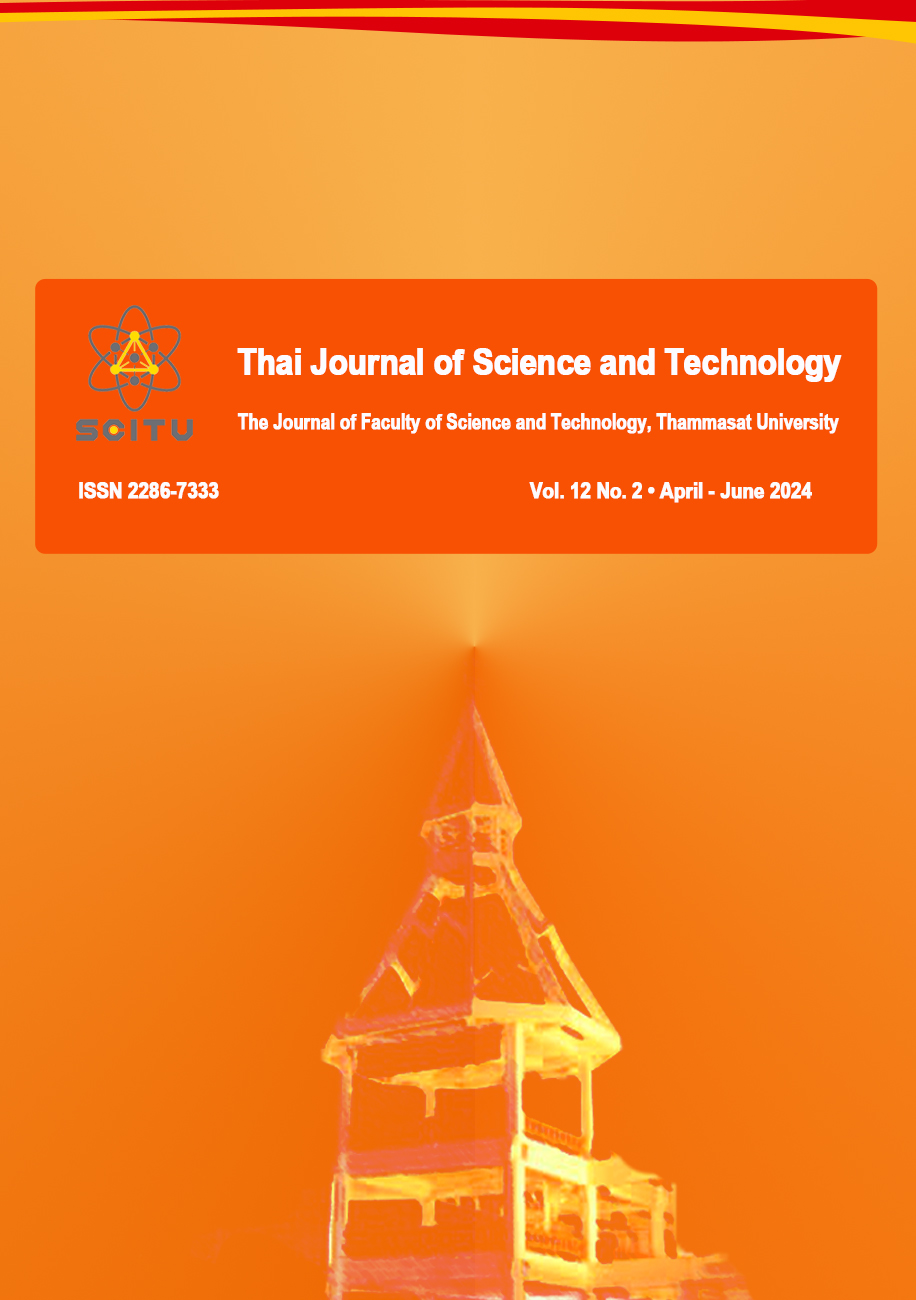อิทธิพลของสารควบคุมการเจริญเติบโตต่อผลผลิตและองค์ประกอบทางเคมีของดอกกระดังงาโนรี
Main Article Content
บทคัดย่อ
การใช้สารควบคุมการเจริญเติบโตของพืช เพื่อกระตุ้นจำนวนดอก ให้ได้จำนวนดอกดก และศึกษาองค์ประกอบทางเคมีที่สำคัญของดอกกระดังงาโนรี ในพื้นที่จังหวัดนครราชสีมา โดยวางแผนการทดลองแบบสุ่มบล็อกสมบูรณ์ (randomized complete block design : RCBD) ประกอบด้วย 6 สูตร สูตรละ 5 ซ้ำ ได้แก่ (T0 Control ควบคุม) (T1 PBZ : Cytokinin) (T2 PBZ : Ca) (T3 PBZ : Mg) (T4 Cytokinin : Ca) อัตรา 1:1 ส่วน ต่อลิตร และ (T5 Cytokinin : Ca : Mg) อัตรา 1:1:1 ส่วน ต่อลิตร โดยฉีดพ่นทุก 15 วันหลังปลูกเป็นเวลา 2 เดือน บันทึกจำนวนดอก และผลผลิตน้ำหนักดอกสด ทุก 15 วัน จำนวน 5 ครั้ง พบว่า ช่วงอายุ 105 วัน T2 และ T4 มีจำนวนดอก มากที่สุด เท่ากับ 64 ดอกต่อต้น และผลผลิตน้ำหนักดอกสด 89.91 และ 86.79 กรัม ตามลำดับ มีความแตกต่างกับกลุ่มควบคุมที่ให้จำนวนดอก และผลผลิตดอกน้อยที่สุด ซึ่งแสดงให้เห็นว่าการใช้สารควบคุมการเจริญเติบโตและธาตุอาหารพืชมีผลต่อการกระตุ้นทำให้ต้นกระดังงาโนรีออกดอกดก จากการศึกษาองค์ประกอบทางเคมีในน้ำมันหอมระเหยจากดอกกระดังงาโนรี พบว่ามีองค์ประกอบหลักที่สำคัญทั้งหมด 47 ชนิด ส่วนใหญ่จะให้สารในกลุ่ม Terpenes เป็นหลัก ซึ่งเป็นสารประกอบที่ให้กลิ่นที่เป็นเอกลักษณ์สามารถนำไปใช้ประโยชน์ในอุตสาหกรรมต่างๆ ต่อไป
Article Details

อนุญาตภายใต้เงื่อนไข Creative Commons Attribution-NonCommercial-NoDerivatives 4.0 International License.
บทความที่ได้รับการตีพิมพ์เป็นลิขสิทธิ์ของคณะวิทยาศาสตร์และเทคโนโลยี มหาวิทยาลัยธรรมศาสตร์ ข้อความที่ปรากฏในแต่ละเรื่องของวารสารเล่มนี้เป็นเพียงความเห็นส่วนตัวของผู้เขียน ไม่มีความเกี่ยวข้องกับคณะวิทยาศาสตร์และเทคโนโลยี หรือคณาจารย์ท่านอื่นในมหาวิทยาลัยธรรมศาสตร์ ผู้เขียนต้องยืนยันว่าความรับผิดชอบต่อทุกข้อความที่นำเสนอไว้ในบทความของตน หากมีข้อผิดพลาดหรือความไม่ถูกต้องใด ๆ
เอกสารอ้างอิง
Barker, V.A., & Pilbeam, J.D. (2015). Handbook of Plant Nutrition. CRC Press Taylor, New York. 1, 1-774.
Bennett, W.F. (2008). Nutrient Deficiencies and Toxicities in Crop Plants. Cambridge University Press, USA. 202 pages.
Chalermklin, P. (2016). Hybrids of the ylang-ylang family. Agricultural housing, 1, 195-199. doi: file:///C:/Users/hp/Downloads/TAB000125600420c.pdf.
Chatpaisarn, A., Laohakunjitn, N., & Kerdchoechuen, O. (2010). Identification of Components Michelia alba DC. Essential Oil by Solid-Phase Micro Extraction Head Space Gas Chromatography Mass Spectrometry. Agricultural Science Journal, 41(3), 641-644.
Ferber, S.G., Namdar, D., Hen-Shoval, D., Eger, G., Koltai, H., Shoval, G., Shbiro, L., & Weller, A. (2020). The "Entourage Effect": Terpenes Coupled with Cannabinoids for the Treatment of Mood Disorders and Anxiety Disorders. Current neuropharmacology, 18(2), 87-96. doi: 10.2174/1570159X17666190903103923.
Guzman, S.L., Bonilla, H., Gomez, R., & Reyes, R. (2015). Linalool and β-pinene exert their antidepressant-like activity through the monoaminergic pathway. Life Sciences, 128(1), 24-29. doi: 10.1016/j.lfs.2015.02.021.
Hirschi, K.D. (2004). The calcium conundrum. Both versatile nutrient and specific signal. Plant Physiology, 136(1), 2438-2442. doi: https://academic.oup.com/plphys/article/136/1/2438/6112388.
Hopkins, W.G., & Huner, N.P.A. (2008). Introduction to Plant Physiology, 4th edition. Wiley Texbooks, 528p.
Jiramonkolkarn, U. (2022). Collection of fragrant flowering plants. Amarin Printing and Publishing, Baan Lae Suan Publishing House. 264 p.
Phatin, R., Kanlayawatanakul, M., & Laorit, N. (2009). Aromatherapy and essential oils in the Thai spa business. Isaan Journal of Pharmacy, 5(2), 160-166.
Pierik, R. (1997). In vitro Culture of Higher Plants. Martinus Nijhoff Publishers, Netherland. 344 p.
Punjee, P., Dilokkunanant, U., Sukkatta, U., Vajrodaya, S., Haruethaitanasan, V., Pitpiangchan, P., & Rakthaworn, P. (2009). Scented extracts and essential oil extraction from Michelia alba D.C. Proceedings of 47th Kasetsart University Annual Conference: Science. (p.p. 404-411). The Thailand Research Fund, Bangkok (Thailand).
Russo, E.B. (2011). Taming THC: Potential cannabis synergy and phytocannabinoid-terpenoid entourage effects. British Journal of Pharmacology, 163(7), 1344–1364. doi: https://www.ncbi.nlm.nih.gov/pmc/articles/PMC3165946/.
Sillapavisal, W., & Netmueang, N. (2015). The Study of Chemical Compositions and Antibacterial Activity of Flower and Leaves in White Champaka (Michelia Alba D.C.). In Proceedings of 12th Kasetsart University Annual Conference: Science. Kasetsart University, Bangkok.
Thongampai, P. (1994). Plant hormones and synthetic substances. Wichai Printing, Bangkok. 196 pages.
White, P., & Broadley, M. (2003). Calcium in Plants. Annals of botany, 92(4), 487–511. doi: 10.1093/aob/mcg164.


